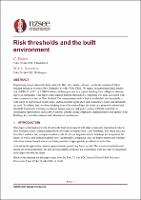| dc.description.abstract | Engineering and building design inherently deal with risk. But risk is rarely—if ever—explicitly considered. Most building design in Aotearoa New Zealand (i.e., to B1/VM1 NZS1170) targets an annual individual fatality risk (AIFR) of 1e-6, or 1 in 1,000,000 chance of any individual dying per year in a typical building from collapse or damage due to an earthquake. While accepted internationally as a threshold that provides sufficiently low risk to society, the 1e-6 fatality risk threshold is vague at best regarding who chose it, and how. Additionally, designers have little to no clarity on how design choices can tangibly affect a building's AIFR, which itself is conditional on probability of damage or probability of collapse. How do the choices a structural designer makes affect a building's probability of damage, of collapse, and subsequently of an individual death? And, by how much?
Elsewhere in the built environment we find more examples of inconsistent risk thresholds, including the earthquake-prone building system, and managing buildings in emergencies (i.e., ‘red/yellow/white sticker’). This trend also extends beyond the built environment, across natural hazard risk, resource management, climate change adaptation, and environmental considerations.
This paper will outline the lack of consideration and inconsistency of risk thresholds in the built environment (and beyond) and make recommendations for a national risk threshold framework. The framework will provide consistent terminology and definitions, as well as clear treatment options for levels of risk, while still allowing flexibility and bespoke approaches in risk assessment and policy implementation. | |

